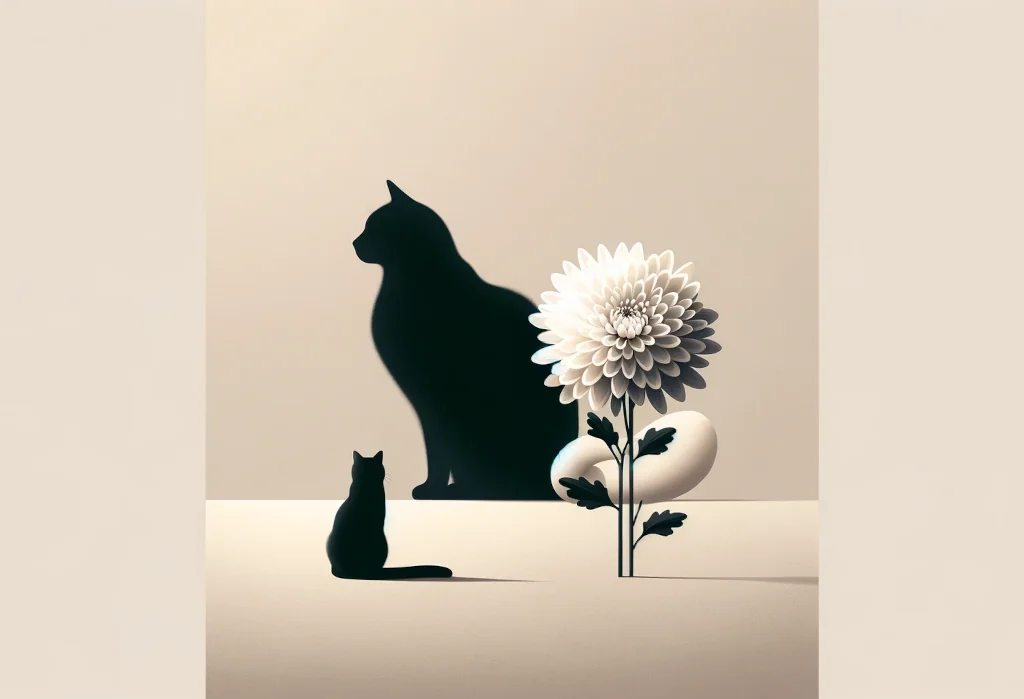Cats and flowers: a picturesque duo until your furry friend decides to take a nibble on your beautiful bouquet. Chrysanthemums, though stunning, might not be the best centerpiece if you’re a cat owner. Ever found yourself eyeing your cat as they eye up your flower display, wondering if you’re about to make an unscheduled trip to the vet?
This blog post unlocks the mystery around chrysanthemums and their safety for your feline friends, helping you maintain a safe and vibrant home environment for them.
Key takeaways:
- Chrysanthemums contain pyrethrins, toxic to cats; immediate vet consultation is essential after ingestion.
- Watch for symptoms: vomiting, excessive drooling, and skin irritation around the mouth.
- Keep chrysanthemums out of reach, opt for cat-safe plants, and secure your planters firmly.
Are Chrysanthemums Dangerous for Cats?
Let’s cut to the chase: Yes, chrysanthemums (“mums” for short) definitely aren’t the best floral choice for cat owners. These popular flowers contain several compounds that are toxic to cats, including pyrethrins.
Pyrethrins are natural insecticides that plants use for defense. Sounds handy for the plant, not so much for our feline friends. Not only can these substances irritate your cat, but they could lead to more severe health issues if not addressed promptly. So, while mums might brighten up your living space, they can cast a shadow over your cat’s health – something we want to avoid at all costs.
What Happens if My Cat Eats a Chrysanthemum?
If curiosity gets the better of your cat and they decide to nibble on a chrysanthemum, be on the lookout for the following symptoms:
- Vomiting and diarrhea: Your cat’s body may attempt to rid itself of the toxin this way.
- Hypersalivation: Excessive drooling is often a telltale sign of oral irritation.
- Dermatitis: In more severe contact cases, your cat could develop skin irritation around the mouth or other parts of their body.
Recognizing these symptoms early could be crucial in preventing more serious complications. It’s not just about what’s happening on the inside; skin issues like dermatitis also indicate chrysanthemum exposure.
How Quickly Should I React if My Cat Eats a Chrysanthemum?
Time is of the essence. If you suspect your cat has had a date with a chrysanthemum, don’t wait around to see if symptoms develop. Contact your vet immediately. Here’s a nugget of advice that could make all the difference: If possible, take a small sample of the consumed plant or take pictures with your phone. This can help your vet to swiftly identify the culprit and decide on the fastest treatment route.
When it comes to acting fast, here’s what’s crucial:
- Remove any remaining plant matter from your cat’s reach.
- Observe your cat closely for any of the symptoms mentioned above.
- Call your vet or an emergency pet poison hotline.
Quick action can mitigate the effects of the toxin and ensure your cat receives the necessary care without delay.
Remember, while chrysanthemums’ vibrant colors and full blossoms can light up any room, their hidden risks to our feline companions can’t be ignored. Keeping these flowers out of reach or opting for non-toxic alternatives can help maintain your home as a safe sanctuary for your curious cat. Taking these measures, along with knowing what to do in case of an accidental ingestion, ensures your pet remains healthy and happy.
Bear in mind, there’s more to safeguarding your pet than steering clear of chrysanthemums. Stay tuned for further insights on how to keep your furry friend safe from other common household hazards.
How Can I Keep My Cat Safe Around Flowers?
So, you’re a proud cat parent and a flower enthusiast? Marvelous combo! However, as we’ve discovered, not all flowers, including chrysanthemums, play nice with our feline friends. Fear not, though! There are plenty of ways to keep your cat safe, happy, and healthy around your botanical beauties. Let’s dive into some practical tips and safer floral alternatives, ensuring peace and harmony in your green space.
Training and Deterrence
1. Establish Boundaries: Cats are intelligent creatures. With patience and consistent training, you can teach them to steer clear of certain areas or plants. Use a firm “no” and gently move them away when they venture too close to your plants. Over time, they’ll learn where they’re not supposed to go.
2. Safe Deterrents: Consider using natural, cat-safe deterrents around your plants. Citrus peels or a light misting of vinegar around your greenery can work wonders, as cats generally dislike these scents. However, make sure any deterrent you use is non-toxic and safe for both your plants and pets.
3. Provide Alternatives: Sometimes, the best deterrent is a distraction. Offering cat-friendly plants like catnip or cat grass gives your feline friend their own plants to enjoy, potentially reducing their interest in your more dangerous blooms.
Choosing Safe Flowers and Plants
Opting for cat-safe flowers and plants is a foolproof way to avoid any potential health hazards. Here’s a list of non-toxic options that are both beautiful and safe for your feline friend:
– Roses: Though thorns can pose a physical hazard, the plant itself is non-toxic to cats. Just make sure to remove any thorns to prevent injuries.
– Orchids: These exotic beauties are safe for cats and can add a touch of elegance to any space.
– Snapdragons: Bright and charming, snapdragons are a safe addition to cat-inhabited households.
– Herb Gardens: Many herbs, including basil, thyme, and cilantro, are safe for cats. Plus, they’re handy for your cooking needs!
Remember, even with non-toxic plants, it’s always a good idea to monitor your pet. Some cats might have a nibble out of curiosity, which, while not poisonous, could still lead to an upset stomach.
An Often Overlooked Tip
Secure Your Planters
Here’s a nugget of advice that’s often missed: securing your planters firmly. Cats, being the curious and sometimes havoc-wreaking creatures they are, might see your planters as toys or climbing obstacles. To prevent any unplanned plant-toppling (and potential ingestion of harmful plants in the chaos), ensure your planters are stable and, if possible, hang them out of paws’ reach. This practice not only keeps your plants safe from curious nibblers but also prevents any accidents that could lead to broken pots and scattered soil.
In wrapping up, while the worry of toxic plants like chrysanthemums can add a wrinkle to your plant-loving, cat-caring lifestyle, it’s nothing a bit of knowledge and precaution can’t iron out. Remember, every cat is different, and what works for one may not work for another. Stay observant, be patient, and you’ll find a happy balance that allows both your feline friend and your plant collection to thrive together.
For further details on non-toxic plants and flowers, the ASPCA provides an extensive list that can come in handy. Keep this resource bookmarked for easy reference: ASPCA Non-Toxic Plants.
There you have it, cat and plant lovers! Embrace these tips, make smart plant choices, and enjoy the beauty of your botanicals without any pet-related fears.
Alex, a passionate animal lover, has experience in training and understanding animal behavior. As a proud pet parent to two dogs and three cats, he founded AnimalReport.net to share insights from animal experts and expand his knowledge of the animal kingdom.





